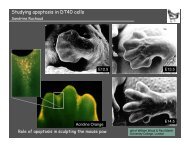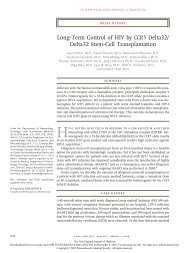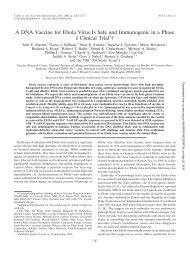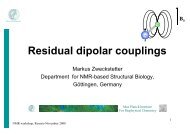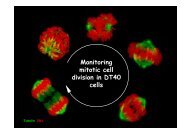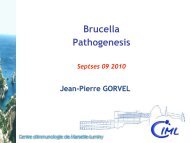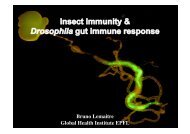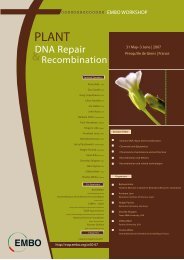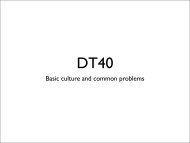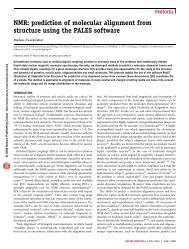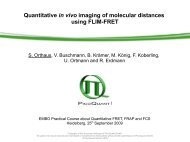You also want an ePaper? Increase the reach of your titles
YUMPU automatically turns print PDFs into web optimized ePapers that Google loves.
<strong>Shigella</strong> effectors <strong>at</strong> work<br />
Invasion of the gut epithelium by <strong>Shigella</strong>: the Yin and Yang of inn<strong>at</strong>e immunity<br />
2 nd lecture
Antimicrobial<br />
molecules<br />
COMMENSALS<br />
Absence (limit<strong>at</strong>ion) of virulence factors<br />
PAMPs less agonist ?<br />
Sequestr<strong>at</strong>ion, weak activity of TLRs<br />
Life in biofilms on mucus surface<br />
Controled diffusion and sampling of PAMPs<br />
And prokaryotic signalis<strong>at</strong>ion molecules<br />
TLR<br />
QSM MDP<br />
OCTN2 PepT1<br />
?<br />
Regul<strong>at</strong>ory<br />
cascade<br />
NLR<br />
Regul<strong>at</strong>ory genes<br />
Regul<strong>at</strong>ory cytokines, chemokines<br />
Mucus<br />
Imm<strong>at</strong>ure DC & MΦ M<br />
Treg<br />
DC<br />
PATHOGENS<br />
Mucinases<br />
Adhesins / Invasins<br />
Type III / IV secretory systems<br />
Hemolysins<br />
Massive engagement of TLRs, NLRs<br />
Eradic<strong>at</strong>ion of commensal fmicrobiota (niche occupancy)<br />
+ Dampening inn<strong>at</strong>e / inflamm<strong>at</strong>ory responses<br />
TLR<br />
PMN<br />
Pro-inflamm<strong>at</strong>ory<br />
cascade<br />
NLR<br />
Pro-inflamm<strong>at</strong>ory Pro-inflamm<strong>at</strong>ory<br />
genes<br />
Pro-inflamm<strong>at</strong>ory<br />
Pro-inflamm<strong>at</strong>ory<br />
cytokines, chemokines<br />
Activ<strong>at</strong>ed DC & MΦ M<br />
Th1 / Th17<br />
PMN
HISTOPATHOLOGY OF SHIGELLOSIS ELEMENTARY LESIONS IN HUMAN COLON<br />
SURFACE EPITHELIUM<br />
CRYPTS<br />
LUMEN<br />
ULCERATED ABSCESS MUSCULARIS MUCOSAE<br />
SUBMUCOSAL TISSUES<br />
<strong>Shigella</strong> flexneri : Endemic form<br />
<strong>Shigella</strong> sonnei : Endemic form<br />
<strong>Shigella</strong> dysenteriae 1 ( Shiga toxin) toxin)<br />
: Epidemic form<br />
<strong>Shigella</strong> boydii : Sporadic form
OspD1<br />
MxiE<br />
« First wave » of<br />
effectors expressed<br />
<strong>at</strong> 37°C prior to<br />
activ<strong>at</strong>ion of TTSS<br />
OspD1<br />
IpaA<br />
virF virB<br />
37°C<br />
ipaBCDA-ipg(s) ipg(s)-mxi - spa (mxiE)<br />
IpaB IpgC<br />
IpaD<br />
IpaD<br />
IpaD<br />
IpaC<br />
virF virB<br />
37°C<br />
IpgC<br />
osp(s)-ipaH(s)<br />
Spa15<br />
IpaA<br />
IpgE<br />
IpgD<br />
osp(s)-ipaH(s)-virA<br />
OspD1<br />
MxiE<br />
ipaBCDA-ipg(s) ipg(s)-mxi - spa (mxiE)<br />
IpaB<br />
IpaD IpaD<br />
IpaD<br />
IpaC<br />
IpgD IpgD<br />
IpaA IpaA<br />
IpaD<br />
MxiE MxiE<br />
MxiE<br />
MxiE<br />
IpgC<br />
IpgC<br />
IpaD<br />
MxiE<br />
IpaB IpaB<br />
<strong>Shigella</strong><br />
IpaD IpaD<br />
IpaD<br />
IpaD IpaD<br />
Inactive TTSS in<br />
absence of<br />
cellular target<br />
IIpaC IIpaC<br />
IpgC<br />
Activ<strong>at</strong>ed TTSS in<br />
presence of<br />
cellular target<br />
IpgD<br />
OspD1<br />
Buchrieser et al., 1998, Mol.Microbiol.
The <strong>Shigella</strong> invasion p<strong>at</strong>hogenicity<br />
island<br />
ipg<br />
Entry <strong>Effectors</strong><br />
ipa<br />
Secretion and Export<strong>at</strong>ion of Ipas: Ipas:<br />
TTSS<br />
mxi<br />
ipg<br />
A D C B C B A<br />
icsB<br />
ipg<br />
spa<br />
D E F G H I J K N L M E D C A 15 47 13 32 33 24 9 29 40<br />
D
Model of assembly of the TTSS<br />
Outer membrane<br />
ring<br />
(secretin/pilotin)<br />
MxiD<br />
MxiM<br />
Sani et al., 2006<br />
Veenendaal et al., 2007<br />
IpaD<br />
+ IpaB<br />
Sec-dependent Sec-independent / TTSS dependent<br />
MxiH<br />
MxiI<br />
MxiA,<br />
Spa40, 24, 29, 9, 13? MxiK, N MxiI Spa32 Secretion<br />
MxiJ<br />
inner rod Needle length<br />
Spa33,<br />
MxiG<br />
control/ of effector<br />
Spa 47 (ATPase) substr<strong>at</strong>e switch molecules<br />
Inner membrane ring<br />
Needle assembly and secretion<br />
From Abdelmounaim Allaoui
Posters of the III rd type:<br />
Marlise Amstutz et al.: deciphering the assembly of the<br />
Yersinia type III secretion injectisome.<br />
Clotilde Bongrand et al.: Transcriptional regul<strong>at</strong>ion by<br />
the secretion activity in <strong>Shigella</strong> flexneri.<br />
Fabian Giska et al.: Genomic and proteomic analysis to<br />
identify regul<strong>at</strong>ory mechanisms of type III secretion system<br />
in Pseudomonas syringae<br />
Dorothea Roehrich et al.: Regul<strong>at</strong>ion of type III secretion<br />
in <strong>Shigella</strong> flexneri: interactions of MxiC th<strong>at</strong> control<br />
secretion.
S.flexneri capture and entry into HeLa cells<br />
Grompone et al., submitted
A. Zipper mechanism<br />
Invasin<br />
Yersinia<br />
Invasin medi<strong>at</strong>ed entry<br />
FAK<br />
β β<br />
integrins<br />
Microtubules<br />
Invasin<br />
B. Trigger mechanism<br />
A<br />
Salmonella<br />
Cdc42/Rac<br />
SopB<br />
IP5 IP4<br />
Src<br />
Rac<br />
N-WASP<br />
B B<br />
C C<br />
SopE SptP<br />
GEF<br />
FAK<br />
Cdc42/Rac<br />
Internalin medi<strong>at</strong>ed entry<br />
E-cadherin<br />
Myo<br />
PIP2<br />
IpgD<br />
PIP<br />
InlA<br />
Cortactin<br />
P<br />
InlA<br />
β β<br />
α<br />
α<br />
C<strong>at</strong>enins<br />
Rac<br />
WSP<br />
Cdc42/Rac<br />
x Sip/Ipa proteins<br />
GAP<br />
WSP WASP family protein<br />
E-cadherin<br />
<strong>Shigella</strong><br />
B<br />
C<br />
VirA<br />
Vez<strong>at</strong>in<br />
Myo<br />
B C<br />
Src<br />
Listeria<br />
P P<br />
Vinculin<br />
A<br />
Rho<br />
p190GAP<br />
Microtubules<br />
InlB (bacterial<br />
<strong>at</strong>tached or free)<br />
VASP<br />
P<br />
Met<br />
Rac<br />
WAVE<br />
InlB medi<strong>at</strong>ed entry<br />
=<br />
P<br />
LIM-K<br />
InlB<br />
Cbl<br />
Gab1<br />
Shc<br />
P<br />
P<br />
P<br />
PIP2<br />
PI3K<br />
Cofilin<br />
PIP3<br />
Type III secretion<br />
appar<strong>at</strong>us<br />
Actin<br />
Arp2/3 complex<br />
Rho GTPases<br />
Bacterial proteins<br />
VASP<br />
Cossart & Sansonetti,Science, 2004
IcsA<br />
?<br />
Vacuole lysis<br />
(TTSS)<br />
?<br />
mucus<br />
Motility, cell to cell<br />
spread (TTSS)<br />
Epithelial cells<br />
Basol<strong>at</strong>eral<br />
macropinocytosis (TTSS)
Alto et al.<br />
Ohya et al.<br />
IpgB<br />
ELMO/Dock<br />
GEF<br />
Wish<br />
Wip<br />
C<br />
Cdc42 Rac<br />
Nck<br />
?<br />
N-WASP<br />
<strong>Shigella</strong><br />
B<br />
Grb2<br />
B<br />
C N N C<br />
GEF<br />
Arp2,3<br />
C<br />
<strong>Shigella</strong><br />
Irsp53<br />
Wave<br />
Actin co<strong>at</strong>, co<strong>at</strong>,<br />
pseudoadherence plaque<br />
inefficient <strong>at</strong> proceeding to internaliz<strong>at</strong>ion<br />
N<br />
VirA<br />
Microtubules<br />
Sasakawa et al.<br />
Hydrophobic domains Coiled-coil Coiled coil domain<br />
IpaC-dependent Actin<br />
nucle<strong>at</strong>ion<br />
polymeriz<strong>at</strong>ion<br />
remodeling<br />
LOADING OF SWISS 3T3 CELLS<br />
WITH IpaC AND anti-IpaC mAbs<br />
Tran Van Nhieu et al., <strong>EMBO</strong> J. 1998<br />
COOH
IpaC-dependent actin nucle<strong>at</strong>ion, polymeriz<strong>at</strong>ion, remodeling<br />
Wish<br />
Wip<br />
N<br />
Cdc42 Rac<br />
Nck<br />
?<br />
N-WASP<br />
<strong>Shigella</strong><br />
C<br />
B<br />
C<br />
Grb2<br />
B<br />
N<br />
Arp2,3<br />
C<br />
C<br />
<strong>Shigella</strong><br />
Irsp53<br />
Wave<br />
N COOH<br />
?<br />
c-Srcc- Src<br />
P P P<br />
Cortactin<br />
Crk<br />
PPP PPP<br />
Cortactin Cortactin<br />
Arp2,3<br />
IpgD<br />
IpgD-medi<strong>at</strong>ed<br />
IpgD medi<strong>at</strong>ed release of membrane tension force<br />
through PI(4,5)P2 phosph<strong>at</strong>ase activity<br />
Bundling of actin<br />
filaments (actin ( actin cup) cup<br />
and depolymeriz<strong>at</strong>ion<br />
(barbed barbed-end end capping) capping)<br />
induced by<br />
the IpaA-Vinculin IpaA Vinculin complex<br />
<strong>Shigella</strong><br />
Vinculin<br />
IpaA<br />
Vinculin<br />
IpaA<br />
Tran Van Nhieu et al., 1998, <strong>EMBO</strong> J.<br />
Bourdet-Sicard et al., 1999, <strong>EMBO</strong> J.<br />
Niebühr Nieb hr et al., 2002, <strong>EMBO</strong> J.<br />
Bougnères Bougn res et al., 2004, J.Cell J. Cell Biol. Biol<br />
Ramarao et al., 2007, FEBS Letters<br />
Mouunier et al., 2009, PLoS P<strong>at</strong>hogens
IpaC last 72 aa fused to iota Ia component (Ic ( Ic) )<br />
induce actin-foci actin foci-like like structures<br />
Src inhibitor (10 µM)<br />
Focal plans, distance in µm from cell basal surface Mounier et al., 2009, PLoS P<strong>at</strong>hogens
Bernardini et al., PNAS,<br />
1989<br />
IcsA<br />
Glycin-rich repe<strong>at</strong>s<br />
Activ<strong>at</strong>ion<br />
of N-WASP<br />
3<br />
G-actin<br />
2<br />
3 2<br />
Arp2/3complex<br />
Capping<br />
protein<br />
F-actin<br />
Activ<strong>at</strong>ion of<br />
Arp2/3 complex<br />
3<br />
3<br />
α-actinin<br />
2<br />
2<br />
3<br />
2<br />
Tread milling<br />
ADF/Profilin<br />
IcsA<br />
vacuole lysis<br />
(TTSS)<br />
epithelial cells<br />
basol<strong>at</strong>eral<br />
macropinocytosis<br />
(TTSS)<br />
mucus<br />
motility<br />
cell to cell spread<br />
(TTSS)
Rupture, invasion and inflamm<strong>at</strong>ory destruction of the intestinal<br />
epithelium by <strong>Shigella</strong>: the key steps of TTSS function.<br />
TTSS<br />
PGN<br />
IL-8, other cytokines<br />
chemokines<br />
Nod1<br />
NF-κB<br />
JNK<br />
Pro-inflamm<strong>at</strong>ory<br />
genes<br />
3<br />
Defensins and other bactericidal<br />
molecules<br />
PNN<br />
- Development of inflamm<strong>at</strong>ion<br />
- Rupture of epithelial barrier<br />
- Facilit<strong>at</strong>ion of invasion<br />
- Stimul<strong>at</strong>ion of epithelial bactericidal<br />
capacities<br />
CCL-20<br />
DC<br />
Follicle-associ<strong>at</strong>ed epithelium<br />
M cell<br />
MΦ<br />
1 2<br />
Lympho B<br />
MΦ<br />
pyroptosis<br />
TTSS/IpaB<br />
«facilit<strong>at</strong>ed<br />
transloc<strong>at</strong>ion»<br />
IcsA<br />
?<br />
- Activ<strong>at</strong>ion of caspase-1<br />
- Pyroptosis = proinflamm<strong>at</strong>ory<br />
apoptosis<br />
- Release of IL-1β and IL-18<br />
?<br />
Vacuole lysis<br />
(TTSS)<br />
Escape to<br />
autophagy<br />
initi<strong>at</strong>ion of inflamm<strong>at</strong>ion subepithelial release of bacteria<br />
mucus<br />
Motility, cell to cell<br />
spread (TTSS)<br />
Epithelial cells<br />
Basol<strong>at</strong>eral<br />
macropinocytosis (TTSS)
<strong>Shigella</strong> life style <strong>at</strong> mucosal surface - Sign<strong>at</strong>ure Tagged Mutagenesis<br />
2900 STM mutants<br />
screened vs M90T/wt in<br />
the rabbit lig<strong>at</strong>ed intestinal<br />
loop model<br />
15 severely defective mutants identified...<br />
- 7 LPS-biogenesis mutants<br />
West et al., Science, 2005<br />
- fnr : virulence of <strong>Shigella</strong> rel<strong>at</strong>ed to oxygen<br />
tension<br />
Strain<br />
M90TDfnr<br />
M90TDfnr pBM2<br />
BS176<br />
Competitive<br />
Index (C.I.)<br />
0.05<br />
0.6<br />
0.8<br />
Rabbit ileal loop model<br />
18 hours infection<br />
M90TDfnr pBM2<br />
INPUT<br />
M90T M90TDfnr<br />
M90TDmxiD<br />
OUTPUT<br />
Marteyn et al., N<strong>at</strong>ure, 2010
Adapt<strong>at</strong>ion of <strong>Shigella</strong> to the gut environment<br />
<strong>Shigella</strong> is protected against wasteful secretion in gut<br />
anaerobic environment. Marteyn et al., N<strong>at</strong>ure, 2010<br />
TTSS<br />
MxiH<br />
IpaB<br />
IpaC<br />
- FNR-dependent inactiv<strong>at</strong>ion<br />
of Spa32/33 expression<br />
- No switch in substr<strong>at</strong>es (MxiH Ipas)<br />
- Elong<strong>at</strong>ion of needles<br />
- Secretion of Ipas blocked<br />
- Accumul<strong>at</strong>ion of Ipas<br />
Secretion signal ?<br />
« incompetence /<br />
priming »<br />
FNR<br />
Fe/S Fe/S<br />
X<br />
GFP-expressing E.coli<br />
Actin/LPS<br />
DAPI<br />
Intestinal lumen<br />
Epithelium<br />
- FNR does not bind to<br />
Spa32/33 regul<strong>at</strong>ors<br />
- Switch in substr<strong>at</strong>es<br />
(MxiH Ipas)<br />
- Secretion of Ipas upon<br />
signal<br />
« competence »<br />
ApoFNR<br />
spa32/33 spa32/33<br />
TTGATATCAA<br />
100-200 mm<br />
Secretion signal<br />
3-5 mmHg<br />
20-70 mmHg<br />
O 2
LPS/LBP<br />
MD2/CD14<br />
TLR4<br />
(LRR)<br />
TIRAF<br />
TRAM<br />
TIRAP<br />
MyD88<br />
TRAF6/2<br />
MEK<br />
MAPK<br />
IRAK1<br />
IRAK4<br />
-P<br />
-P<br />
p38 JNK Erk1/2<br />
Histone H3 tail<br />
S10 P<br />
K9 Met<br />
K14 Ac<br />
P38/Erk P38/Erk<br />
P P<br />
NF-κB<br />
MAPK-TFs<br />
RICK/RIP2<br />
NF-κB<br />
Pol II II<br />
Card Card NBS<br />
IKK<br />
P<br />
NF-κB<br />
IκB<br />
SCF βTRCP<br />
IκB<br />
Ub<br />
UbUb<br />
S10 P<br />
K9 Met<br />
K14 Ac<br />
Nucleosome<br />
Heterochrom<strong>at</strong>in<br />
Induction of inn<strong>at</strong>e immunity genes<br />
« inflamm<strong>at</strong>ion »<br />
Nod2<br />
Nod1<br />
E2<br />
Ub<br />
Ub<br />
(LRR)<br />
PGN<br />
(Muropeptides)<br />
Proteasomal<br />
degrad<strong>at</strong>ion<br />
Nod1 apical staining in TC7 epithelial cells<br />
(confirmed confirmed in vivo)<br />
Kufer et al., Cell.Microbiol<br />
Cell Microbiol., ., 2008<br />
Colocaliz<strong>at</strong>ion of Nod1 and IKKγ IKK (NEMO)<br />
Inflamm<strong>at</strong>ory medi<strong>at</strong>ors: medi<strong>at</strong>ors medi<strong>at</strong>ors: iNOS, iNOS iNOS, , Cox2<br />
Adhesion molecules: molecules molecules: : VCAM, ICAM, E-Selectin E- E-Selectin Selectin<br />
Cytokines/chemokines<br />
Cytokines/ Cytokines/chemokines: chemokines: : IL-6, IL-8, TNFα, TNF TNFα, , MCP-1,<br />
MIP-1α, MIP-1 MIP-1α, , CCL20, ...<br />
Antimicrobial peptides and associ<strong>at</strong>ed molecules<br />
Girardin et coll., <strong>EMBO</strong> Repts, 2001<br />
Pédron dron et al., J.Biol J. Biol.Chem Chem., ., 2002<br />
Girardin et coll.., Science, 2003<br />
Girardin et coll., J.Biol.Chem., 2003
GlcNAc<br />
O<br />
O<br />
CH<br />
O<br />
HCCH<br />
3<br />
CO<br />
CO CH 3<br />
L-Ala<br />
D-Glu<br />
MurNAc<br />
NH<br />
Meso-DAP DAP<br />
O<br />
<strong>Shigella</strong><br />
<strong>Shigella</strong><br />
?<br />
LRR<br />
NBS/NACHT<br />
CARD<br />
RICK<br />
IKK<br />
MTP<br />
JNK<br />
Pro-inflamm<strong>at</strong>ory<br />
genes activ<strong>at</strong>ed<br />
by NF-κB<br />
Nod1<br />
Functions<br />
of Nod1<br />
Caspase 9<br />
Apoptosis<br />
Girardin et coll., <strong>EMBO</strong> Repts, 2001<br />
Girardin et coll.., Science, 2003<br />
Girardin et coll., J.Biol.Chem., 2004
Gal-3 localizes to the phagosomal membrane and fusing structures<br />
Bacteria<br />
Gal-3<br />
Immune response<br />
Prolifer<strong>at</strong>ion<br />
Non-lectin<br />
domain<br />
Ph<br />
Development<br />
CBD<br />
B<br />
Differenti<strong>at</strong>ion<br />
15-30 min<br />
Cancer progression<br />
Apoptosis, Cell cycle, Splicing, Transcription, Cell adhesion<br />
Inflamm<strong>at</strong>ion<br />
Paz I et coll. sous presse
cytokines<br />
chemokines<br />
Inhibition of autophagy<br />
(Atg4BC74A)<br />
Ogawa M & al., Science, 2005<br />
NF-kB NF-kB<br />
cytokines<br />
chemokines<br />
Polyubiquitinyl<strong>at</strong>ed/SUMOyl<strong>at</strong>ed proteins (bacteria/host cell ?), and Galectin-3<br />
Recruitment of pro-inflamm<strong>at</strong>ory signaling pl<strong>at</strong>form (TRAF6-Ub, NEMO, NOD)<br />
Recruitment of Autophagy, sequestosome proteins (LC3, P62)<br />
Host cell membranes th<strong>at</strong> compose the<br />
bacterial-containing vacuole contribute (upon<br />
rupture) as « signaling pl<strong>at</strong>forms » to elicit<br />
cellular inn<strong>at</strong>e responses.<br />
Targeting to autophagy regul<strong>at</strong>es inflamm<strong>at</strong>ion<br />
by removing degraded membranes .<br />
Paz et al., Cell.Microbiol., 2010<br />
Ray et al., Cell Microbiol., 2010<br />
Dupont et al., Cell Host & Microbe, 2009<br />
Autophagy<br />
IcsA/Atg5<br />
IcsB<br />
Deregul<strong>at</strong>ion of<br />
inn<strong>at</strong>e immune response<br />
MEF cells<br />
2H
Participit<strong>at</strong>ion of membrane remnants in NF-κB response to p<strong>at</strong>hogen<br />
invasion in MEF cells<br />
(autophagy-dependent modul<strong>at</strong>ion of the inflamm<strong>at</strong>ory response)<br />
Increase of NF-κB<br />
activ<strong>at</strong>ion<br />
Membrane remnants: pro-inflamm<strong>at</strong>ory signaling pl<strong>at</strong>form upon <strong>Shigella</strong> invasion.<br />
2H
37°C<br />
Contact<br />
virF virB<br />
ipaC ipaB ipgC mxi-spa mxiE ipaHs ospBCDEFG<br />
IpaC<br />
IpgC<br />
IpaB<br />
IpgC<br />
virF virB<br />
MxiE<br />
OspD1<br />
TTSS<br />
ipaC ipaB ipgC mxi-spa mxiE ipaHs ospBCDEFG<br />
IpaC<br />
IpgC<br />
IpaB<br />
MxiE MxiE<br />
IpgC IpgCOspD1<br />
OspD1 IpgC<br />
IpaC IpaB<br />
MxiE<br />
OspD1<br />
IpaH<br />
IpaH<br />
Osp<br />
Osp<br />
?<br />
Regul<strong>at</strong>ory cascade controling<br />
transcription of ipaH & osp genes<br />
in response to two external signals:<br />
(1) temper<strong>at</strong>ure<br />
(2) TTSS activ<strong>at</strong>ion<br />
The mxiE regulon<br />
AraC-family transcription<br />
activ<strong>at</strong>or: MxiE<br />
Anti-activ<strong>at</strong>or: OspD1<br />
Coactiv<strong>at</strong>or: IpgC<br />
Anti-coactiv<strong>at</strong>ors: IpaB, IpaC<br />
Parsot C, Demers B, Mavris M,<br />
Penno C, Bongrand C et al.
Xenotransplant<strong>at</strong>ion of human fetal intestine<br />
subcutaneously in SCID mice<br />
Mouse<br />
mice Collabor<strong>at</strong>ion with Samuel Stanley<br />
(Washington University, University,<br />
St Louis)<br />
Human<br />
Target genes of the MxiE-dependent<br />
effectors<br />
Chemokines & chemokine receptors:<br />
CCL3, CCL4, CCL20, CCL25,<br />
CCRL2<br />
Cytokines and cytokine receptors:<br />
IL-7, IL-18, IL-13RA1, IL-20RA<br />
Antimicrobial peptides:<br />
HBD1, HBD3



